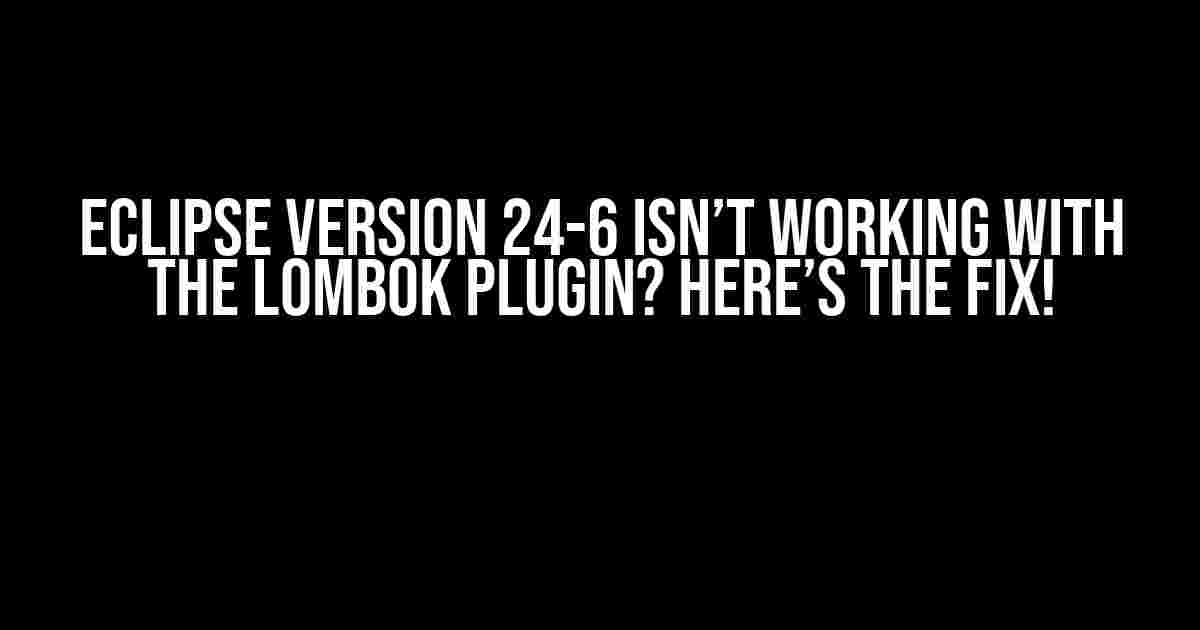As a developer, there’s nothing more frustrating than encountering an issue that halts your workflow. One of the most common problems that Eclipse users face is the incompatibility between Eclipse version 24-6 and the Lombok plugin. In this article, we’ll guide you through the steps to resolve this issue and get your development environment up and running smoothly.
- What’s Lombok, and Why Do You Need It?
- The Problem: Eclipse Version 24-6 and Lombok Incompatibility
- Step 1: Uninstall Lombok and Eclipse
- Step 2: Download and Install Eclipse 2022-06 (or Later)
- Step 3: Install Lombok via the Eclipse Marketplace
- Step 4: Configure Lombok in Eclipse
- Step 5: Verify Lombok is Working Correctly
- Troubleshooting Common Issues
- Conclusion
What’s Lombok, and Why Do You Need It?
Lombok is a popular Java library that automatically plugs into your development environment (IDE) to reduce boilerplate code. It’s a game-changer for developers, as it saves time and increases productivity. With Lombok, you can focus on writing clean, concise code instead of repetitive, redundant code.
Imagine not having to write getters and setters for your Java classes, or having to implement the `toString()` method from scratch. That’s what Lombok offers – a convenient way to simplify your coding experience.
The Problem: Eclipse Version 24-6 and Lombok Incompatibility
The issue arises when you try to use Lombok with Eclipse version 24-6. Unfortunately, this version of Eclipse includes significant changes that break compatibility with Lombok. The plugin fails to work as expected, leaving you with error messages and a non-functional development environment.
But don’t worry; we’ve got you covered! In the following sections, we’ll provide step-by-step instructions to resolve this issue and get Lombok working seamlessly with Eclipse version 24-6.
Step 1: Uninstall Lombok and Eclipse
Before we begin, you need to uninstall Lombok and Eclipse from your system. This will ensure a clean slate for the installation process. Follow these steps:
- Close Eclipse, if it’s currently running.
- Go to the Eclipse installation directory (usually `C:\Program Files\Eclipse\` on Windows or ` Applications/Eclipse/` on Mac).
- Delete the entire Eclipse directory to remove the installation.
- Uninstall Lombok from your system (if you’ve installed it separately).
Step 2: Download and Install Eclipse 2022-06 (or Later)
The next step is to download and install a compatible version of Eclipse. You can use Eclipse 2022-06 or a later version, as these releases have resolved the compatibility issues with Lombok.
Follow these steps to download and install Eclipse:
- Visit the official Eclipse website (https://www.eclipse.org/downloads/) and download the Eclipse IDE for your operating system (Windows, Mac, or Linux).
- Choose the Eclipse package that suits your needs (e.g., Eclipse IDE for Java Developers).
- Download the installation file (usually a `.zip` or `.dmg` file).
- Extract the contents of the downloaded file to a directory on your system (e.g., `C:\Program Files\Eclipse\` on Windows or `Applications/Eclipse/` on Mac).
- Open the Eclipse folder and run the `eclipse.exe` file (on Windows) or `Eclipse.app` (on Mac) to launch the application.
Step 3: Install Lombok via the Eclipse Marketplace
Now that you have a compatible version of Eclipse installed, it’s time to install Lombok via the Eclipse Marketplace. Follow these steps:
- Open Eclipse and navigate to the
Helpmenu. - Click on
Eclipse Marketplaceto open the marketplace dialog. - In the search bar, type “Lombok” and press Enter.
- Select the Lombok plugin from the search results and click the
Installbutton. - Wait for the installation to complete, then restart Eclipse.
Step 4: Configure Lombok in Eclipse
After installing Lombok, you need to configure it in Eclipse. This step is crucial to ensure that Lombok works correctly with your Java projects.
Follow these steps to configure Lombok in Eclipse:
- Open Eclipse and navigate to the
Windowmenu. - Click on
Preferencesto open the Preferences dialog. - In the Preferences dialog, navigate to
Lombokunder theJavasection. - In the Lombok preferences, ensure that the
Enable annotation processingcheckbox is selected. - Apply the changes and close the Preferences dialog.
Step 5: Verify Lombok is Working Correctly
The final step is to verify that Lombok is working correctly with your Eclipse installation. Create a new Java project in Eclipse and add the following code:
@Data
public class Person {
private String firstName;
private String lastName;
public Person(String firstName, String lastName) {
this.firstName = firstName;
this.lastName = lastName;
}
}
Now, hover over the `Person` class in the Eclipse editor. You should see the Lombok annotations (`@Data`) and the generated getters and setters. If you see an error or no annotations, check your Lombok configuration and ensure that annotation processing is enabled.
Troubleshooting Common Issues
If you encounter issues during the installation or configuration process, refer to the following troubleshooting tips:
| Issue | Solution |
|---|---|
| Lombok is not recognized by Eclipse | Check that you’ve installed Lombok via the Eclipse Marketplace and configured it correctly in the Eclipse preferences. |
| Error messages during Lombok installation | Try reinstalling Lombok or checking the Eclipse error log for more information. |
| Lombok annotations are not recognized in Java code | Verify that you’ve enabled annotation processing in the Lombok preferences and that your Java project is configured to use the correct Java version. |
Conclusion
In this article, we’ve provided a comprehensive guide to resolving the incompatibility issue between Eclipse version 24-6 and the Lombok plugin. By following the steps outlined above, you should be able to get Lombok working seamlessly with your Eclipse installation.
Frequently Asked Questions
Q: Will this solution work for older versions of Eclipse?
A: No, this solution is specifically designed for Eclipse version 24-6 and later. If you’re using an older version of Eclipse, you may need to upgrade to a compatible version or seek alternative solutions.
Q: Can I use Lombok with other IDEs, like IntelliJ or NetBeans?
A: Yes, Lombok is compatible with various IDEs, including IntelliJ IDEA and NetBeans. However, the installation and configuration process may differ depending on the IDE.
Q: How do I report issues or request features for Lombok?
A: You can report issues or request features for Lombok on the official Lombok GitHub page (https://github.com/projectlombok/lombok/issues). The Lombok community is active and responsive to user feedback.
Here is the HTML code for the FAQ about “Eclipse version 24-6 isn’t working with the lombok plugin”:
Frequently Asked Question
If you’re struggling to get Eclipse version 24-6 to work with the Lombok plugin, you’re not alone! Here are some common issues and their solutions.
Why does Eclipse 24-6 refuse to recognize the Lombok plugin?
This might be due to a compatibility issue between the two. Try checking if you’re running the latest version of Lombok and if it’s compatible with your Eclipse version. You can do this by going to the Lombok installation directory and looking for the `lombok.version` file.
Have you tried reinstalling Lombok?
You’d be surprised how often this simple fix works! Try uninstalling Lombok from Eclipse, then reinstall it. Make sure to restart your Eclipse after the reinstallation. If you’re still having issues, try checking the Eclipse error log to see if there are any error messages related to Lombok.
Can I use an older version of Lombok with Eclipse 24-6?
While it’s possible to use an older version of Lombok, it’s not recommended. Lombok’s developers have made significant changes to the plugin to ensure it’s compatible with newer Eclipse versions. Using an older version might lead to more compatibility issues. Instead, try updating Lombok to the latest version or seeking help from the Lombok community.
Should I try cleaning my Eclipse workspace?
Yes! Sometimes, Eclipse can get a bit messy, and cleaning the workspace can help. Go to File > Invalidate Caches / Restart, then try reinstalling Lombok. If that doesn’t work, try deleting the Eclipse workspace and starting from scratch. This will remove any duplicate or corrupted files that might be causing issues.
What if none of these solutions work?
Don’t panic! If none of the above solutions work, you can try seeking help from the Eclipse or Lombok communities. There are many online forums and resources available where you can post your issue and get help from experienced developers. You can also try checking the Lombok issue tracker to see if someone else has reported a similar issue.


